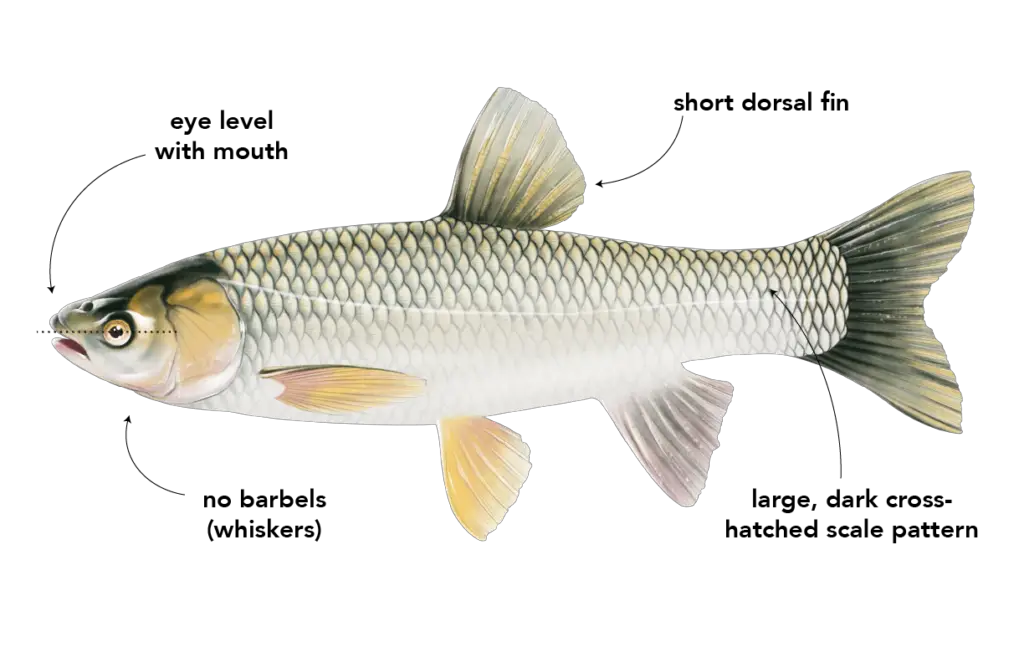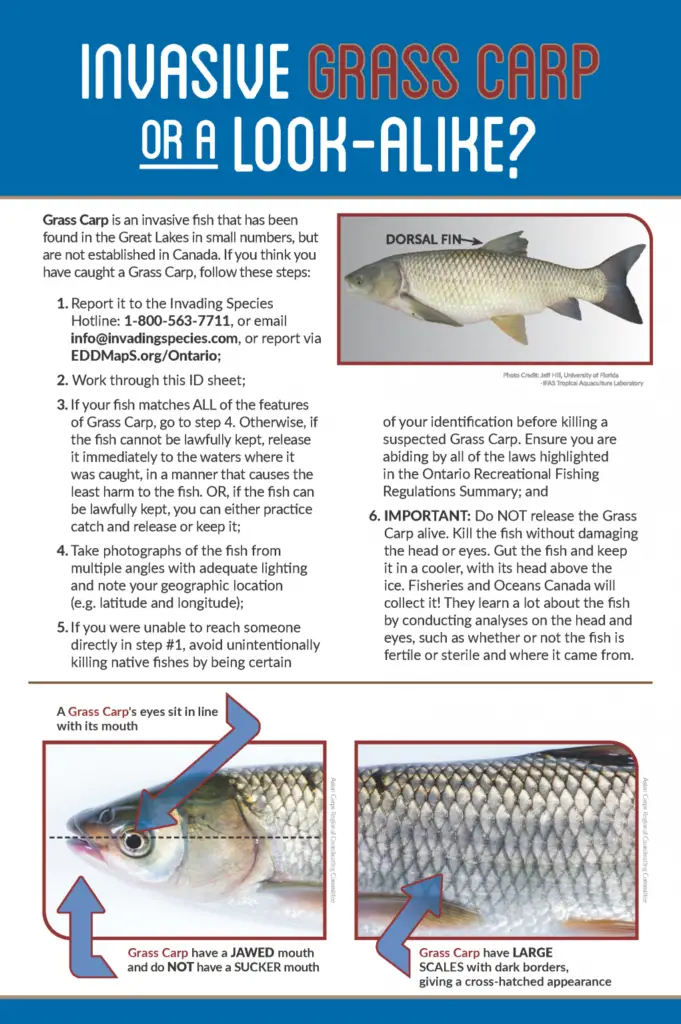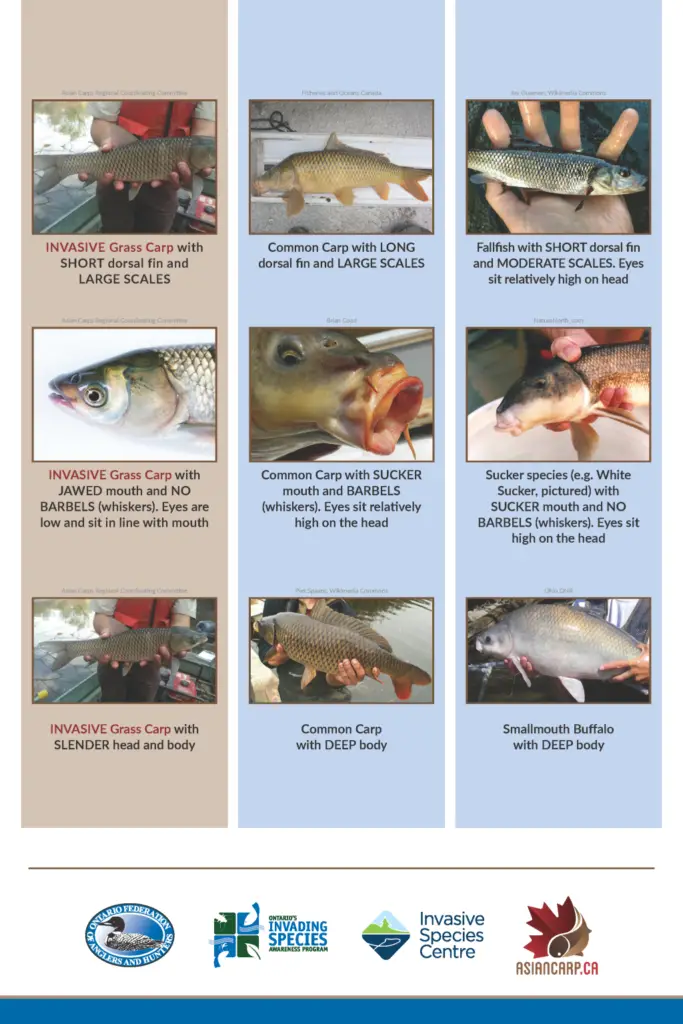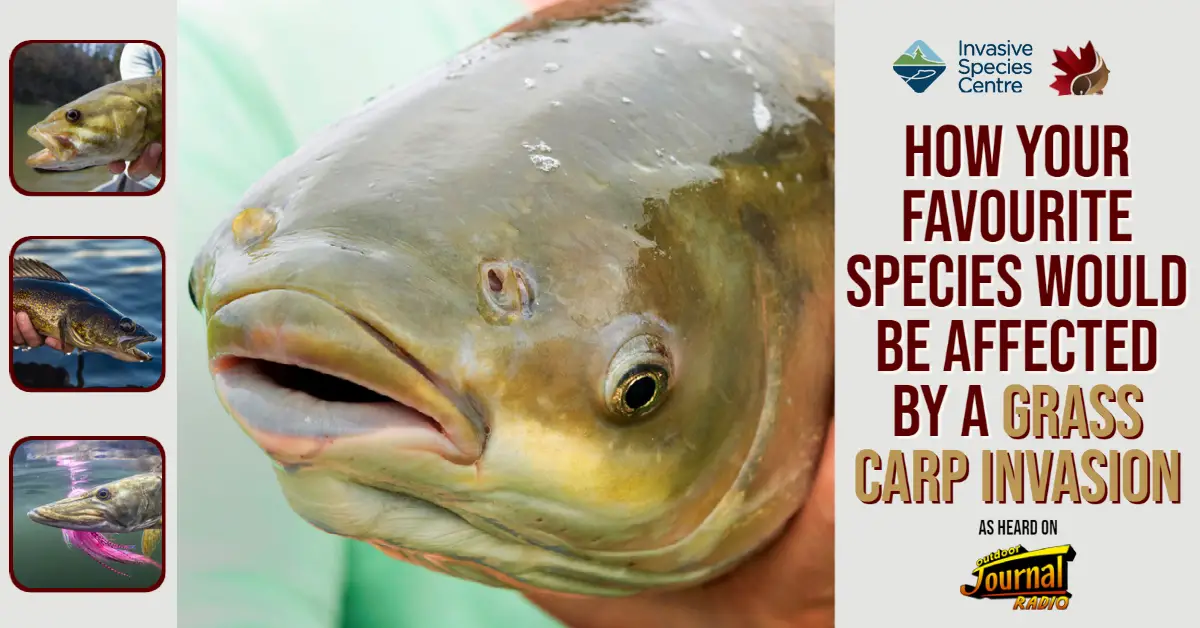Grass Carp, one of the four species of Asian carps, are threatening to invade the Great Lakes. Researchers have recently found evidence of natural reproduction in the Sandusky and Maumee rivers, both tributaries of Lake Erie on the U.S. side. This puts them at a striking distance from the Canadian waters of the Great Lakes and makes them the most immediate threat! However, there is currently no evidence of an established population in Canadian waters. Our goal is to keep it this way!
What’s the big deal?
Grass Carp can eat up to 40% of their body weight a day in aquatic plants. They can reach up to 5 ft long and more than 80 lbs in weight – that’s a lot of aquatic plants!
Just 10 Grass Carp per hectare can reduce aquatic plants by up to 50%. This is a huge threat to the Great Lakes ecologically and economically. They can only digest about half of the plant material they consume each day and expel the remaining material, which pollutes the water and promotes algal blooms. They can also grow very large, very quickly, outgrowing the gape (mouth) size of any native predators that could control their populations.

Impacted Species
Due to their voracious diets, Grass Carp would cause negative impacts to a predicted 33 fish species in the Great Lakes! This includes some of our favourites to fish for such as Walleye, Smallmouth Bass, Muskellunge, Yellow Perch, Northern Pike, and Largemouth Bass.
Walleye
Walleye are known to deposit eggs within aquatic plants during the spawning season. Due to the voracious diets of Grass Carp, eating 40% of their body weight a day in aquatic plants would decrease the spawning success for Walleye.
Smallmouth Bass
The extreme diets of Grass Carp give them the ability to outcompete many native species and organisms for resources. This could dramatically alter the food web that Smallmouth Bass rely on as a top predator.
Muskellunge
Much like Northern Pike, Muskie use aquatic plants to help ambush prey, and even use these plants to deposit their eggs onto when spawning. Due to the large amounts of aquatic plants that Grass Carp consume daily, the spawning success of Muskie could be reduced, as well as their ability to ambush prey.
Yellow Perch
Yellow Perch typically use aquatic plants for spawning grounds and to help hide from predators. If Grass Carp were to establish in Canadian waters, they would consume a lot of this aquatic plant material that Yellow Perch rely on for suitable habitat.
Northern Pike
Northern Pike are opportunistic feeders that use areas with heavy plants for feeding and lurking. They are also known to spawn randomly within patches of aquatic plants and deposit their eggs onto these plants. Due to the feeding habits of Grass Carp, Northern Pike would experience negative impacts on spawning and predatory success.
Largemouth Bass
Largemouth Bass are usually found in dense weedy areas. Grass Carp, eating up to 40% of their body weight a day in aquatic plants, put Largemouth Bass at risk due to habitat loss.
Native species that would experience moderate to high impacts:
– Spotted Gar
– Longnose Gar
– Bowfin
– Northern Redbelly Dace
– Brassy Minnow
– Redfin Shiner
– Golden Shiner
– Pugnose Shiner
– Bridle Shiner
– Blackchin Shiner
– Blacknose Shiner
– Mimic Shiner
– Pugnose Minnow
– Lake Chubsucker
– Bigmouth Buffalo
– Yellow Bullhead
– Grass Pickerel
– Central Mudminnow
– Banded Killifish
– Blackstripe Topminnow
– Green Sunfish
– Pumpkinseed
– Warmouth
– Bluegill
– White Crappie
– Black Crappie
– Least Darter
– Gizzard Shad
– White Sucker
– White Bass
How Can I Spot a Grass Carp?

Grass Carp have large, dark cross-hatched scales and a short dorsal fin. Their eyes sit in the middle of their head, and they don’t have barbels (whiskers). Learn more about Grass Carp identification and check out some commonly confused species here.
What Can I Do?
The most important thing you can do as an angler is learn how to identify Grass Carp and report all sightings of suspected Grass Carp. In Ontario, you can report to the Invading Species Hotline (1-800-563-7711), the EDDMaps App (Available for Apple and Android), or eddmaps.org.


Learn More!
Visit www.asiancarp.ca to learn more about the threats of Grass Carp to the Great Lakes and how you can help prevent their establishment in Canadian waters!






One Response
Used to catch them as a kid for fun they were good for the garden